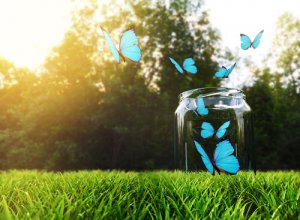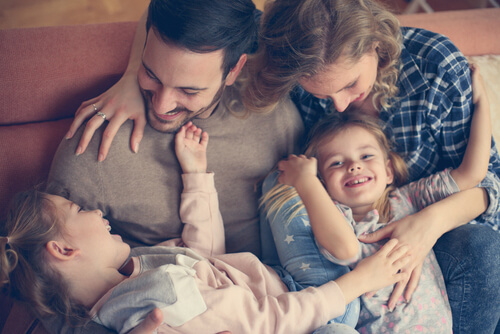The Happiness Bottle Technique: How to Do It and Why It Works


Reviewed and approved by the psychologist Gema Sánchez Cuevas
Interestingly, one of the most beautiful things the great queen of suspense Agatha Christie has said doesn’t have anything to do with mystery. The author said that “one of the most fortunate things that can happen to you in life is to have a happy childhood“.
That’s why today we’re going to see how the happiness bottle technique can help both young and old get happy.
It’s not always easy to think positively, especially for adults who don’t do it very often. It seems that children, in all their innocence, do it in more naturally, wanting to play, laugh and have fun.
A positive attitude
Studies show again and again that a positive attitude is a very powerful weapon in overcoming all kinds of obstacles. And so, encouraging children to develop a positive attitude is so very important. It’s an essential asset for their daily lives, and also brings them hope for their future.
“Children are the most important resource in the world and the best hope for the future”
-John Fitzgerald Kennedy-

The happiness bottle technique can be described as a game that tries to reinforce a positive attitude many children have naturally, and to help create it in those that don’t.
Not all children are as uninhibited as we assume, and many of them are quite capable of facing conflicts and problems with a positive attitude.
How does the happiness bottle technique work?
This technique tries to teach people how to face problems optimistically. And that’s how the famous philosopher Elsa Punset came up with this little game:
It’s a game to be played as a family or group. All the participants choose a good-sized glass jar to be the happiness bottle. The jar should be labelled clearly for all to see, and put in a visible place in the house.
Every day, the participants have to write on a piece of paper the best thing that happened to them in the last 24 hours.
We’re talking about simple things, like a good grade on an exam, a tasty meal, something that went better than you expected, meeting a nice person, etc.
The person then folds the piece of paper and puts it in the jar. Believe it or not, your brain will record these little messages.
Every six months, the family opens the bottle, which by then will be quite full. They they read out loud all the positive messages of what happened to over that time.
The happiness bottle technique: what’s the goal?
But, what is the point of this happiness bottle technique? It’s not just a neat idea. We know for a fact that that the human brain learns a lot — and well — through the classic method of trial and error.
It may be a very basic technique, but it’s worked ever since they first sat us in the high chair and we started to drop toys on the floor.
It’s also well-known that a positive attitude is useful for transforming adverse situations into favorable ones. While it may not be simple, it does give the possibility of turning problems into opportunities.
Therefore, this technique allows:
- Children learn to reflect on all the good things that happen to them at the end of the day. Sometimes they can be very impulsive and impatient, and believe that everything is horrible. This technique shows them that it’s wrong to think that way.
- They learn to appreciate the little things. A kiss, a hug, a nice word… We all have good things happening all the time, but we don’t always have the attitude and predisposition to identify them. To feel them and enjoy them. But by fixing them in our brain, our attitude will change almost without realizing it.
- All members will learn to differentiate big problems from insignificant ones, especially children.
- It’s a very helpful technique, teaching everyone, especially the youngest ones, to learn to be grateful.
- It’s also a fantastic model to improve family and group communication.

So don’t wait! Put the happiness bottle technique into practice with the groups you’re a part of. Let’s create a more positive world.
“The best way to make children happy is to make them happy”
-Oscar Wilde-
Interestingly, one of the most beautiful things the great queen of suspense Agatha Christie has said doesn’t have anything to do with mystery. The author said that “one of the most fortunate things that can happen to you in life is to have a happy childhood“.
That’s why today we’re going to see how the happiness bottle technique can help both young and old get happy.
It’s not always easy to think positively, especially for adults who don’t do it very often. It seems that children, in all their innocence, do it in more naturally, wanting to play, laugh and have fun.
A positive attitude
Studies show again and again that a positive attitude is a very powerful weapon in overcoming all kinds of obstacles. And so, encouraging children to develop a positive attitude is so very important. It’s an essential asset for their daily lives, and also brings them hope for their future.
“Children are the most important resource in the world and the best hope for the future”
-John Fitzgerald Kennedy-

The happiness bottle technique can be described as a game that tries to reinforce a positive attitude many children have naturally, and to help create it in those that don’t.
Not all children are as uninhibited as we assume, and many of them are quite capable of facing conflicts and problems with a positive attitude.
How does the happiness bottle technique work?
This technique tries to teach people how to face problems optimistically. And that’s how the famous philosopher Elsa Punset came up with this little game:
It’s a game to be played as a family or group. All the participants choose a good-sized glass jar to be the happiness bottle. The jar should be labelled clearly for all to see, and put in a visible place in the house.
Every day, the participants have to write on a piece of paper the best thing that happened to them in the last 24 hours.
We’re talking about simple things, like a good grade on an exam, a tasty meal, something that went better than you expected, meeting a nice person, etc.
The person then folds the piece of paper and puts it in the jar. Believe it or not, your brain will record these little messages.
Every six months, the family opens the bottle, which by then will be quite full. They they read out loud all the positive messages of what happened to over that time.
The happiness bottle technique: what’s the goal?
But, what is the point of this happiness bottle technique? It’s not just a neat idea. We know for a fact that that the human brain learns a lot — and well — through the classic method of trial and error.
It may be a very basic technique, but it’s worked ever since they first sat us in the high chair and we started to drop toys on the floor.
It’s also well-known that a positive attitude is useful for transforming adverse situations into favorable ones. While it may not be simple, it does give the possibility of turning problems into opportunities.
Therefore, this technique allows:
- Children learn to reflect on all the good things that happen to them at the end of the day. Sometimes they can be very impulsive and impatient, and believe that everything is horrible. This technique shows them that it’s wrong to think that way.
- They learn to appreciate the little things. A kiss, a hug, a nice word… We all have good things happening all the time, but we don’t always have the attitude and predisposition to identify them. To feel them and enjoy them. But by fixing them in our brain, our attitude will change almost without realizing it.
- All members will learn to differentiate big problems from insignificant ones, especially children.
- It’s a very helpful technique, teaching everyone, especially the youngest ones, to learn to be grateful.
- It’s also a fantastic model to improve family and group communication.

So don’t wait! Put the happiness bottle technique into practice with the groups you’re a part of. Let’s create a more positive world.
“The best way to make children happy is to make them happy”
-Oscar Wilde-
This text is provided for informational purposes only and does not replace consultation with a professional. If in doubt, consult your specialist.







